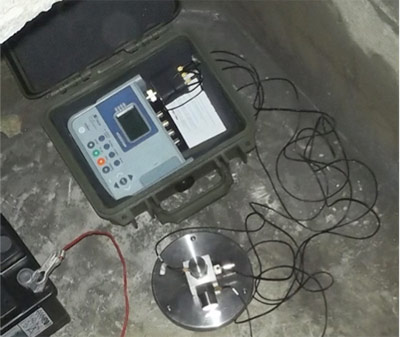TunnelTECH
Keeping underground noise within limits
30 Apr 2013
Steve Summers, Technical Director, Anderson Acoustics
Meeting commitments on ground-borne noise is a critical element of underground construction. UK-based Anderson Acoustics is currently providing noise and vibration monitoring services on a number of tunnel and station contracts. Technical Director Steve Summers reports on progress and methodology for TunnelTalk.
-

Narrow gauge construction loco track at the Royal Oak portal
- As excavation continues on the running tunnels for Crossrail under London, contractors must at all times ensure their underground operations remain within strict and predefined vibration parameters.
- Anderson Acoustics Ltd has been commissioned to carry out vibration measurements on Crossrail's western tunnels. Consultants from Anderson Acoustics Ltd and their sub-consultants Accon UK are the first acoustics professionals to have worked within one of the Crossrail tunnels. Measurements have been carried out at two locations, one at Royal Oak and the second near to Hyde Park.
- The commission forms part of the C300/C410 Western Tunnels & Caverns contract, with Anderson Acoustics appointed as noise and vibration consultants to the joint venture contractor BAM/Ferrovial/Kier (BFK). Anderson Acoustics manages and monitors all aspects of noise and vibration associated with tunnelling and other construction activities at the contract's numerous worksites.
-

Vibration monitoring equipment in man-hole
-
Crossrail noise limits
Vibration readings have been taken at the surface and within the tunnel to measure levels resulting from the passage of the narrow gauge loco that carries concrete segments and other materials to service the TBM. Crossrail has to meet strict undertakings that control the levels of ground-borne noise from the construction railway. This is noise that occurs when the structure of a building re-radiates ground vibration, causing airborne noise within that building. Crossrail's undertakings include internal noise limits set for residential buildings and other building uses, as well as specific undertakings for certain commercial properties which have uses that are particularly sensitive to noise, such as recording studios. Crossrail's standard adopted criteria for ground-borne noise are 40 dB LAmax,S within residential buildings, 30 dB LAmax,S for recording studios and 25 dB LAmax,S for theatres. The LAmax,S index is a measure of the maximum noise level caused by an event such as loco movement. In the surveys carried out, vibration velocity results have been converted into estimated ground-borne noise levels by using a standard relationship. This has been derived from measurements relating vibration to noise levels within buildings above rail tunnels.
-

Vibration monitoring equipment with accelerometer on ground spike
- The vibration measurements have two main purposes. First, to provide a direct indication of ground-borne noise levels for different track types for the temporary construction loco within the tunnel. Second, to provide data to validate the prediction model used to calculate ground-borne noise levels at specific locations. This data has been used to confirm the track types required to achieve the relevant undertakings. Different temporary construction railway track options have been designed incorporating varying levels of vibration isolation.
-
Accelerometer mounting
The vibration monitoring involves a measurement and analysis process that is complex and requires close attention to detail. The sensors used to detect the vibration were accelerometers, and these were connected to a multi-channel data acquisition device used to make digital recordings of the vibration. The measurements in the tunnel, where vibration levels are relatively high, required standard, low sensitivity, accelerometers. Conversely, for measurements at the ground surface, very high sensitive accelerometers were required, which were some of the highest sensitivity devices used to measure environmental vibration. These are capable of measuring vibration down to less than 0.001 m/s2.
- The mounting of accelerometers had to be considered carefully to ensure effective coupling to the vibrating surface. For example, accelerometers within the tunnel were mounted magnetically to purpose-built 20mm thick steel angle brackets, bolted to the tunnel segment. For the surface measurement at Royal Oak, man-holes approximately 1.5m deep were constructed in order to bypass the local ground surface and couple instead with the underlying sub-soil. Smooth concrete floors to the man-holes provided a level surface to support a heavy stainless steel plate on which the accelerometer was mechanically fixed. At Sussex Square, near Hyde Park, steel ground spikes were used. The accelerometers were fixed using magnetic mounts to the spikes which were 350mm long.
-

Steve Summers of Anderson Acoustics
- The digital vibration recordings from the cleanest construction train pass-by events were identified and analysed on a PC using signal processing and analysis software. The acceleration recordings were integrated to give velocity results in 1/3 octave bands using FFT analysis.
- Two main vibration surveys were carried out. The first survey at Royal Oak involved measurements on the standard track type used by BFK for the temporary construction railway in the Western tunnels. This track type only incorporates basic design measures to minimise vibration and ground-borne noise. The results of the measurements showed vibration performance was better than had been predicted.
- The purpose of the measurements at Sussex Square was to measure the performance of the track type that incorporates vibration isolation features within its design. The results of these measurements also indicated the performance was better than our predictions had indicated.
- • Anderson Acoustics is also providing noise and vibration services on a number of other Crossrail contracts including C501 at Liverpool Street and C511 at Whitechapel for the BAM Nuttall/Kier JV, and on the C310 Thames Tunnel contract for the Hochtief/Murphy JV.
-
Delivering noise pollution solutions for Crossrail - TunnelTalk, January 2012
|
|
|
|
|
Add your comment
- Thank you for taking the time to share your thoughts and comments. You share in the wider tunnelling community, so please keep your comments smart and civil. Don't attack other readers personally, and keep your language professional.



